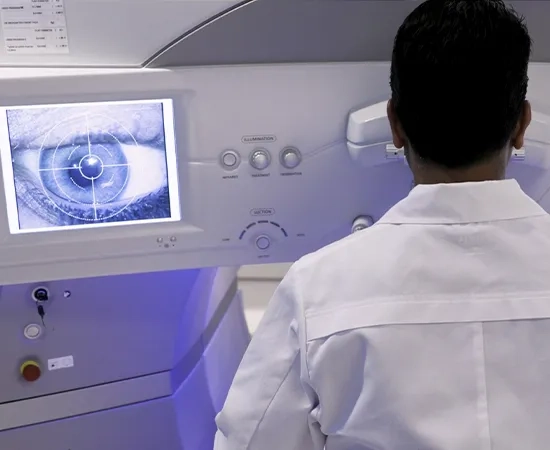SMILE Eye Surgery in Baltimore

With over 10 million successful surgeries performed worldwide, SMILE has quickly become a popular choice among those seeking high‑quality visual results. It’s approved by the FDA as well as all four branches of the U.S. military. At Goel Vision, we’re dedicated to helping you understand your options, including SMILE and how it compares to traditional LASIK.
If you’re experiencing vision issues like astigmatism or myopia, SMILE laser eye surgery could be the ideal solution for you. This advanced, minimally invasive procedure is designed to improve your vision and significantly enhance your quality of life.
What is SMILE Eye Surgery?
SMILE stands for Small Incision Lenticule Extraction. This cutting‑edge laser eye surgery offers a minimally invasive approach to correcting vision problems, particularly myopia and astigmatism.
During the procedure, a femtosecond laser creates a small incision and removes a lenticule (a thin layer of tissue) from the cornea, reshaping it without the need for a corneal flap. This technique provides a highly precise correction with reduced risk of complications and a quicker recovery time compared to traditional LASIK.
Am I a Candidate for SMILE?
One of the benefits of SMILE is that most people with refractive errors are excellent candidates. SMILE is particularly effective for those with nearsightedness and astigmatism, thanks to its precise, high-tech approach.
To be considered for SMILE, candidates should:
- Be at least 18 years old
- Have a stable prescription for at least one year
- Not have any active eye conditions, such as infections or severe dry eye
- Discuss any previous eye surgeries or health issues with Dr. Goel

Find Out If You're a Candidate for SMILE With Our Quick Quiz
Benefits of SMILE
Fast, One Laser Surgery
SMILE is performed in one session. It typically takes only a few minutes, with the laser being used for less than 25 seconds per eye.
Quick Recovery
Since SMILE is less invasive, recovery tends to be quicker. Most patients can return to normal activities, including going to the gym and wearing eye makeup, within a day.
Fewer Side Effects
Patients report fewer incidences of dry eye compared to LASIK, as the procedure does not involve creating a corneal flap.
Minimally Invasive
Utilizing advanced Zeiss technology, SMILE employs extremely fast laser pulses, allowing for more precision. The procedure requires only a small incision, leading to less impact and discomfort.
Discover Allyson’s SMILE Eye Surgery Journey at Goel Vision
Are You Ready to Be Next?
Join thousands of people across Baltimore who have chosen SMILE for clearer vision.

Results of SMILE Surgery
SMILE provides patients with the opportunity to achieve significant improvements in their vision, often noticeable immediately after the procedure. This advanced technology is designed to minimize discomfort and reduce the likelihood of side effects compared to standard LASIK.
Dr. Goel’s specialized expertise in SMILE ensures you’re in experienced hands, guiding you toward the best possible outcomes on your vision correction journey.
The Difference Between LASIK and SMILE
SMILE and LASIK are both equally safe and effective, but they differ in their techniques and applications. The main differences include:
Procedure Technique
LASIK creates a corneal flap that is lifted to reshape the cornea, while SMILE removes tissue through a small incision without creating a flap.
Invasiveness
SMILE is less invasive, as it requires only a small incision to remove a thin layer of tissue, which minimizes disruption to the corneal structure.
Recovery Time
SMILE recovery is often faster and associated with fewer post-surgery side effects, such as dry eye symptoms, offering patients a smoother healing experience.
Precision and Safety
Both LASIK and SMILE are highly precise, but SMILE’s advanced technology streamlines the process with fewer steps and tools, reducing the chance of complications.
Ideal for patients at risk for eye trauma from activities like rock climbing, karate, or MMA

The Cost of SMILE
The cost of SMILE surgery can vary based on several factors, including the surgeon’s experience, the technology used, and your individual vision needs. While SMILE has historically been more expensive than LASIK, advancements in technology and increased availability have made it competitive with LASIK pricing.
At Goel Vision, we strive to make our procedures as accessible as possible. We offer financing options† to help make SMILE surgery more affordable for you, and we are committed to providing a full breakdown of costs during your consultation.
Whether you choose a virtual or in-person consultation, our team will ensure you have all the information you need to make an informed decision about your eye care.
"I have nothing but amazing things to say about Dr. Goel and the whole Goel Vision team. I got the SMILE procedure a week ago, and my results have been fantastic so far.[...] I did extensive searching around DC, Maryland, and Northern VA to find a doctor who had the skillset, reputation, and disposition that I was looking for. Needless to say, my Goel Vision consultation was great—and my actual procedure was everything I hoped it would be. Dr. Goel was caring, patient, and thorough. My recovery has been smooth sailing, and I’m already seeing 20/20. I’m happy to recommend Dr. Goel to anyone looking for laser eye surgery."
![]()
Dr. Andrea Davis
Dr. Sonny Goel
Leading SMILE Surgeon in Baltimore and Columbia, Maryland
Dr. Goel is one of the few Maryland surgeons trained in SMILE laser eye surgery, with over 25 years of experience and 100,000 successful procedures. Serving Baltimore, Columbia, and surrounding areas, he specializes in advanced vision correction tailored to your unique needs.
To see if SMILE is right for you, we offer free virtual and in‑person consultation.